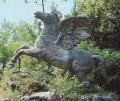
To the sides, the statues installed in the rock correspond to the three local rivers, while the water that gushes from on top recalls the famous waterfalls and caverns of the Monti Tiburtini.
Focal point of the whole fountain is the central statue of the TIBURTINE SIBYL ALSO KNOWN AS ALBUNEA, the goddess who protected the town of Tivoli and who created the legendary Sibylline Books.
The Tiburtine Sibyl was the favourite of the goddess Venus and, not by chance, the rooms that have housed THE LABORATORY-DIDACTIC MUSEUM OF THE ANCIENT BOOK since 1979, are known as the GROTTOES OF VENUS.

The Pegasus Fountain is visible from the Villa's forecourt amid rocks and vegetation, to the back of the Sibyl Albunea. It represents the mythical winged horse that, by striking his hoof on the ground, made the Hippocrene Fountain, sacred to the Muses, gush forth from Mount Helicon. To the Muses, who dwelt in the museum and protected the arts, the scribes donated the instruments of their trade: kalamus, stylus, etc...

The myth of the Sibyl Albunea is the theme of the mural paintings in the Second Tiburtine Room, in the lower apartment of the Villa d'Este. The iconographic programme of the villa's rooms and garden is aimed at glorifying the ancient art of the book and the exceptional culture of Cardinal Ippolito II and his court.
The Sibyl Albunea prophesied the birth of Jesus Christ to the classical world: "NASCETUR CHRISTUS IN BETHLEM, ANNUNTIABITUR IN NAZARETH, REGNANTE TAURO PACIFICO FUNDATORE QUIETIS. OH FELIX ILLA MULIER CUIUS UBERA IPSUM LACTABUNT". Her symbol was a book. The legendary sibylline books were preserved in a golden casket in the Temple of Apollo on the Palatine, in Rome, seat of one of the most ancient public libraries.

In the St. Bernardine Room of the Palazzo Comunale in Tivoli is portrayed the episode, recounted by the historian Suetonius, in which the emperor Octavius Augustus, addressing himself to Albunea, the Sibyl, asked if he could permit himself to be worshipped as a god. The Sibyl then revealed to him who was the one God to whom the emperor too should offer a sacrifice. The altar of that sacred gift was placed in the Roman church known as the Ara Coeli.
